Gingerbread House
Ever wanted to make your very own Gingerbread House at home. but haven’t been sure where to start? This recipe for a homemade Gingerbread House has all you will need, including a FREE printable cut-out template.

I don’t know what it is, but whenever I see a Gingerbread House, the child in me comes alive! I’ve always loved a little homemade biscuit, whether an actual gingerbread house or the ornamental kind you find in garden centres across the land at this time of year. They just fill my heart with so much joy.
Nowadays, you can easily pick up a gingerbread-making kit in most supermarkets, but when I was a kid, these simply didn’t exist. The only way to make a gingerbread house was to do it from scratch. Because of this, most gingerbread houses were more of a modest triangular shape (a “triangular prism”, if we want to be technical). And initially, I set out for this homemade gingerbread house recipe to be the same.
But my imagination ran away with me. I figured if I was going to share a gingerbread house recipe with you all, I would make sure it was the proper house shape. But that also meant I had to provide some sort of dimensions or template, which is exactly what I have done!
As well as my FREE Gingerbread House Template (which you simply download, print and cut out), you’ll also find lots of tips and tricks for building success. Although saying that, the building is always going to be a bit fiddly; there’s just no way around that. But that’s all part of the fun, right?! And any disasters can easily be covered with a bit of strategically placed icing snow.

How do you make a homemade Gingerbread House?
To make a homemade Gingerbread House, you start by preparing your dough. Like my Gingerbread Men recipe, this is a crunchy gingerbread biscuit; made up of flour, sugar, butter, golden syrup, bicarb, cinnamon and (of course) ginger.
Once you have your dough, use your FREE Gingerbread House Template to cut your walls and roof. After baking, you want to let the biscuits cool completely before starting to construct your gingerbread house. You’ll use a slightly thicker icing to stick your walls and roof together, and a slightly thinner icing to decorate – plus any extras you’d like to include too, such as jelly tots, snowflake sprinkles, candy canes…
It can be fiddly but lots of fun! Get the kids involved and make some core childhood memories. Or let your own imagination go wild and create the gingerbread house of your dreams.
Free Gingerbread House Template
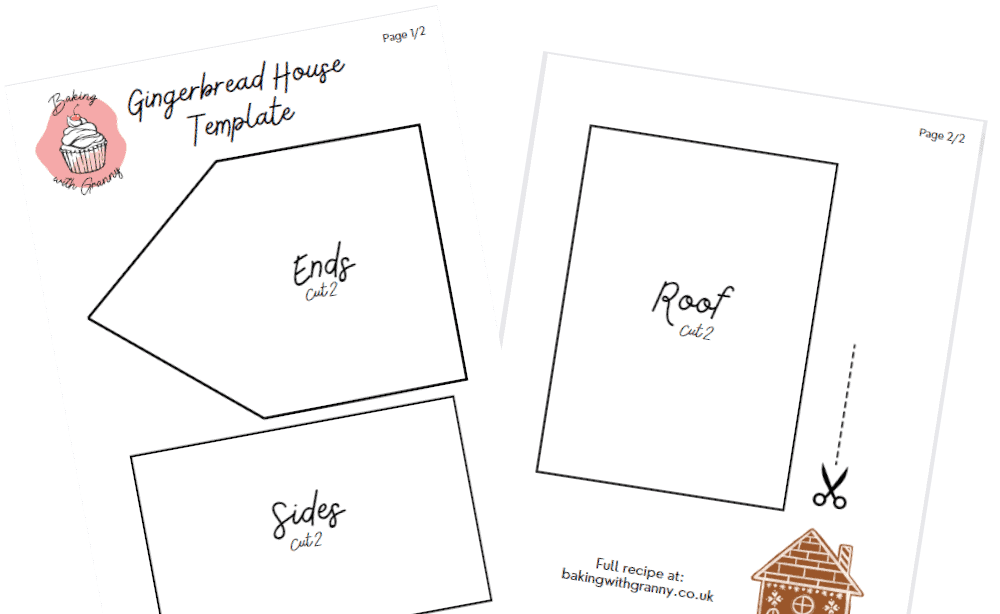
Grab my FREE Gingerbread House template to get the sizes spot-on for your own homemade Gingerbread House.
Simply print-at-home, cut out the template, and use it for your gingerbread house pieces.

Ingredients for Gingerbread House:
Butter or Margarine
As this gingerbread house is loaded with flavour from the ginger & cinnamon, not to mention the sweetness of the sugar and golden syrup, the choice of butter or margarine purely comes down to personal preference, as neither will really enhance or affect the overall taste. I like margarine as a way to omit the dairy (making this a vegan gingerbread house) and because it is less expensive.
If using margarine, just be sure to use a block margarine, as opposed to a spreadable one. The latter will change the overall texture of your biscuit due to having a higher water content.
Soft Light Brown Sugar
A light brown sugar helps give this gingerbread house a recognisable golden hue. You can swap out the sugar for an alternative, like caster sugar, but you will find the colour changes, as does the level of sweetness. Personally, I think the light brown sugar is a must.
Golden Syrup
A real favourite here in the UK! If you’re unfamiliar with Golden Syrup, our guide Golden Syrup – Ingredient 101 is a great place to start. As with most recipes that include Golden Syrup, I recommend not substituting it, as there’s really nothing else out there that will give that distinctively warming flavour. You can easily find Golden Syrup to purchase online; however, if you aren’t able to do this, my recommendation would simply be to omit it from this recipe. It’s really just there to complement the flavours and give some extra crunch whilst baking – your biscuit can still be successful without it.
Plain Flour
Only a small amount of raising agent is used in this recipe for gingerbread biscuits. These aren’t your soft, squidgy, nearly cake-like gingerbread…can you imagine your gingerbread house withstanding its own weight in that case? We want a hard, crunchy biscuit so the walls don’t cave in!
Bicarbonate of Soda
A little bicarb is added to your gingerbread dough. Not much, but just enough to cause a slight reaction with the heat in the oven. This helps achieve a more even bake and texture in your biscuits, and prevents them edging from having a nice bite, to breaking your teeth!
Ground Ginger
A key ingredient, you could say! I like a really obvious ginger taste in my biscuits, so I tend to use heaped teaspoons. If you prefer your ginger a bit more subtle, dial it back a bit, even down to one teaspoon.
Ground Cinnamon
Not something you get in every gingerbread biscuit recipe, but something I consider essential. Cinnamon just adds another dimension to the flavours in these biscuits, complementing both the ginger and sweetness perfectly.
Free Gingerbread House Template

Grab my FREE Gingerbread House template to get the sizes spot-on for your own homemade Gingerbread House.
Simply print-at-home, cut out the template, and use it for your gingerbread house pieces.

Tips for homemade Gingerbread House:
• When mixing your dough, it may seem like it is going to be a bit dry once you’ve added the flour. Don’t worry! Once you get your hands in to help mix, the warmth from your hands will help the butter/margarine soften more and help bring everything together.
• This gingerbread house recipe is a no-chill dough. As soon as you’ve rolled and cut your dough, you can go ahead and bake it. If, however, you are working in a warm kitchen or making them in the heat of summer, you can chill your dough before baking if you feel it needs it.
• I like to split my dough into two when it comes to rolling and cutting, purely because I don’t have enough space in my kitchen to roll out the entire amount at once.
• I find a large palette knife to be invaluable when it comes to making a Gingerbread House. As the biscuits are quite large, they can be quite delicate when it comes to moving onto the baking trays; a palette knife makes this a bit easier. And the biscuits can sometimes curve and spread a little whilst baking – the palette knife can be used to push the edges & straighten them out, when you remove them from the oven.
• After you’ve cut all your walls and roof, use any excess dough and cut some different shapes (stars, trees, people…) to use in decorating your gingerbread house.
• For ease in moving your gingerbread house, construct it onto something you can make part of the overall look. A chopping board or cake board are perfect.
• When it comes to constructing your Gingerbread House, you want a slightly thicker consistency icing than you will use for decorating. There’s no “easy” way to get your Gingerbread House walls together, but if you have a spare pair of hands, they can assist with holding things upright while you attach and “glue” it all together with the icing. Alternatively, keep a few mugs or glasses close by to help prop up the walls as you go.
• It’s not an essential, but when it comes to decorating and you have a cake turntable – use it, it will make life much easier!
• There’s no shame in opting to use Writing Icing Tubes when it comes to decorating. And in fact, they are great for when you’re baking with kids.
• Don’t forget to have fun! Gingerbread House can be fiddly, there’s no two ways about it. You are constructing a building out of biscuits after all! But don’t let the aim of perfection overtake the fun you can have making a house that is uniquely yours.

Free Gingerbread House Template

Grab my FREE Gingerbread House template to get the sizes spot-on for your own homemade Gingerbread House.
Simply print-at-home, cut out the template, and use it for your gingerbread house pieces.
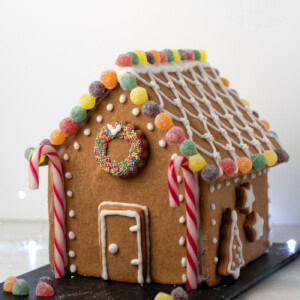
EQUIPMENT
- Sharp Knife
INGREDIENTS
- 200 g Butter or Block Margarine (at room temperature)
- 200 g Soft Light Brown Sugar
- 80 g Golden Syrup
- 400 g Plain Flour (All-purpose Flour)
- 1 tsp Bicarbonate of Soda (Baking Soda)
- 3-4 tsp Ground Ginger
- 2 tsp Ground Cinnamon
To Decorate:
- 400 g Icing Sugar (Powdered Sugar)
- 3-4 tbsp Boiling Water
- Sweeties (Candies) (for decorating)
INSTRUCTIONS
- Pre-heat your oven to 170°c (150°c for fan assisted oven, Gas Mark 3-4 or 325°F) and line a couple of baking sheets with greaseproof paper. Set aside.
- In a large bowl, cream together your butter/margarine and sugar, until light (in texture – the colour will remain darker due to the brown sugar) and fluffy. Add your golden syrup and stir through to combine.
- Sift in your flour, bicarbonate of soda (baking soda), ginger and cinnamon. Mix your dry and wet ingredients together to make a stiff dough – you will probably need to use your hands!
- Gently knead the dough together, before rolling with a rolling pin on a well floured surface, to around 0.5-1cm thick. Using the gingerbread house template, cut out the walls and roof shapes (6 pieces in total) and transfer to your pre-lined baking sheets, leaving a little space between them. Using a large palette knife to support the pieces as you move them will prevent them from breaking.Knead together any off-cut before re-rolling the dough, and use any excess to cut out small biscuit shapes to decorate your house.
- Bake your gingerbread biscuits in your pre-heated oven for 15-20 minutes. When they are golden and dry looking, remove from the oven to cool. Be careful not to overbake your biscuits – this can happen quickly due to the presence of golden syrup in the dough.
- Once baked, remove from the oven and gently push – not cut! – the edges of the biscuits with a large palette knife (or just a normal knife) to help straighten them out a little – they may have spread and curved a little whilst baking, this helps correct this. Allow the biscuits to cool completely on the trays – they will continue to harden as they cool, so don't be tempted to try and lift them before they are completely cool.
- When cold, you can start to construct your gingerbread house. Mix 200g [half] of the icing sugar (powdered sugar) with 1-2 tbsp of boiling water, so you have a thick sticky icing, which is still spreadable but not runny. Start by attaching your walls together – if you can have someone help you hold the walls upright, this will help; alternatively you can prop them up with some mugs or drinking glasses. Be generous with the amount of icing you use, and don't worry about being overly neat – you can easily cover it with some decor. Once you have your walls upright, stick on the roof pieces with plenty icing too. Allow your gingerbread house to dry before decorating.
- Once the icing has dried, you can start decorating your gingerbread house. Mix the remaining 200g of icing sugar (powdered sugar) with 1-2 tbsp of water until it is a piping consistency. You can use a piping bag, or simply drizzle/spoon onto your house. Be creative and have some fun!
IMPORTANT NOTE:
All my recipes are developed using a digital scale and the metric system (grams and millilitres). Cup measurements are available as a conversion but these, unfortunately, won’t always be as accurate. For best results, I always recommend baking with a digital scale.
RECIPE NOTES:
- For full Ingredients explanations and substitutions, please see the Ingredients section above.
- For lots more tips & tricks for success, please see Granny’s Top Tips section above.
- For free-from substitutions to make this a vegan, dairy-free, nut-free, egg-free…gingerbread house, see the Free-from section below.
- Don’t forget to download your FREE Gingerbread House Template before you begin.
Free-from & Vegan:
Gluten-free: In theory, a straight swap to gluten-free flour should work with this recipe to make it a gluten-free gingerbread house. I haven’t tried and tested this though, so can’t say for sure, but if you do try, let me know how you get on.
Nut-free: There’s no nuts used in this gingerbread biscuit recipe. Just be sure to double-check your ingredients individually for any hidden allergens.
Egg-free: No eggs are used in this recipe, making it an eggless gingerbread house. Just be sure to check your ingredients individually if serving to someone with an egg allergy.
Dairy-free: Simply use a dairy-free margarine to make this dairy-free gingerbread house recipe.
Vegan: You can easily make these Vegan Gingerbread House. Simply use a dairy-free margarine, and opt for gelatine-free and dairy-free sweeties to decorate.
N.B. Any advice or suggestions to make recipes “free-from” or vegan are purely that – suggestions. Please be careful to double-check all ingredients individually, taking extra caution when serving to those with allergies & intolerances.
For more info on common food allergies, please see food.gov.uk | For more info on coeliac disease, please see coeliac.org.uk | For more info on a vegan diet, please see vegansociety.com
What is Golden Syrup?
Golden Syrup is a popular baking ingredient in the UK… But what is it? Where can you get it? And what can you use as a substitute?
My in-depth Golden Syrup Guide has all the answers to your questions!

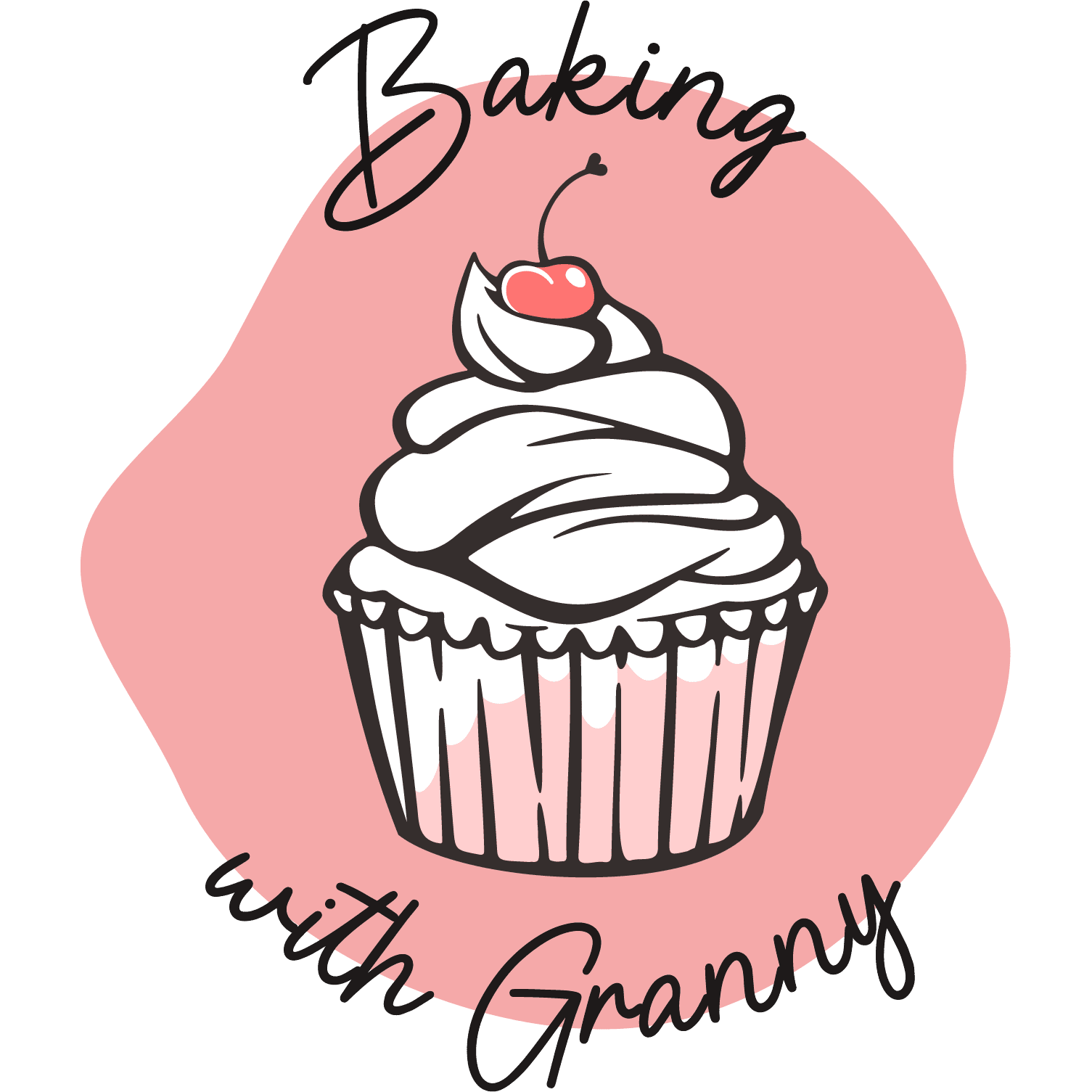

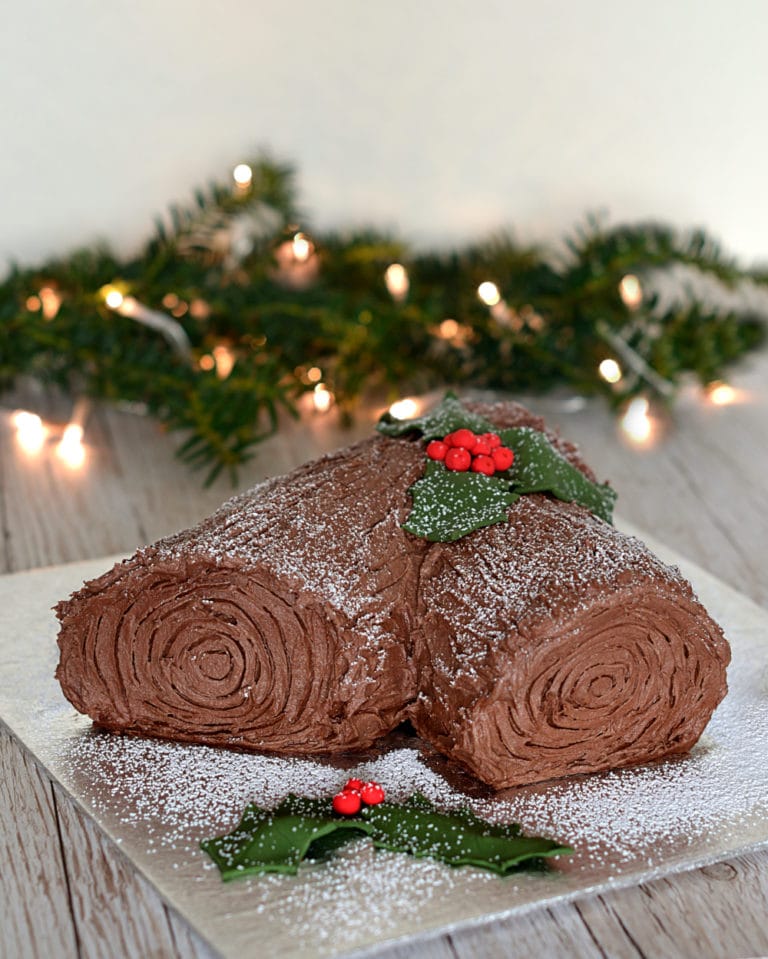
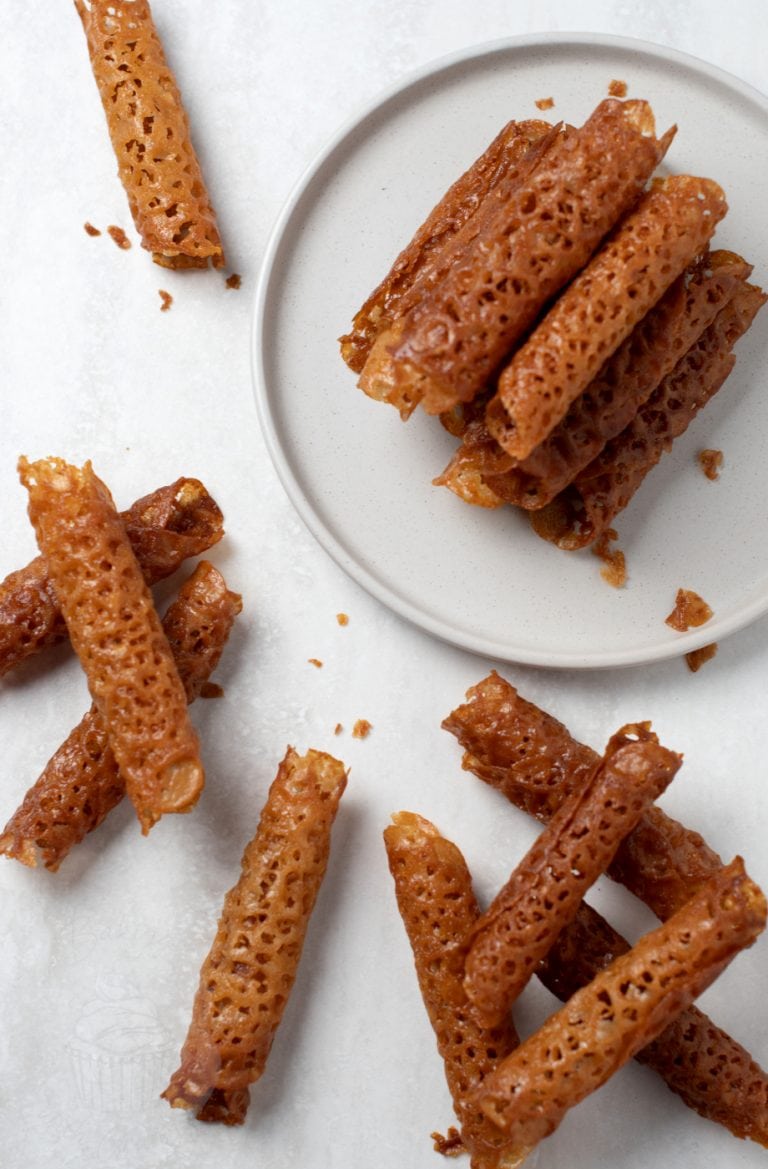

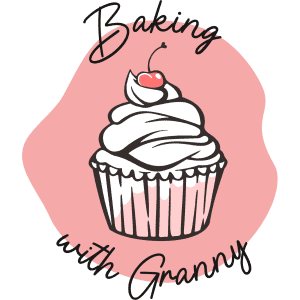
Hi I am unable to download the gingerbread house template, Is there another way I can receive it?
Would love to try this but adverts cover all the method and cant get rid of them so its not possible
Golden syrup on bread and butter yum. Used to be able to get a malty bread, think it , was Hovis One of our lovely neighbours up the stairs gave me a slice of yummy buttered malt bread. Delicious. thank you Amy for the clootie dumpling, tablet and memories of golden syrup. It is also available here in Melbourne in the “imported section” along with other UK specialities. Have a lovely Christmas, lets our temperatures don’t ruin it all.
My dough was extremely dry and difficult to bring together.
I had to add a little water to the mixture as it was just to crumbly to roll out. No matter how much i kneaded it.